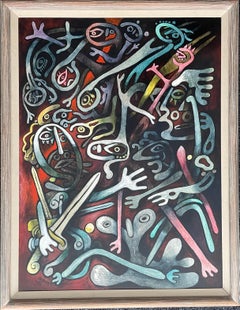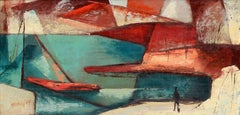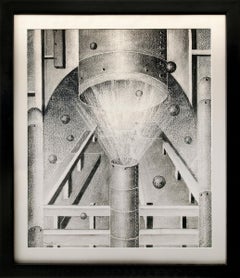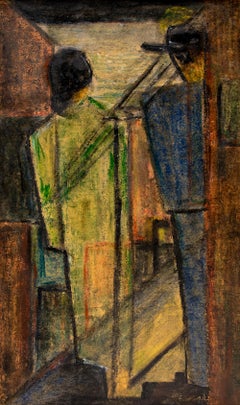American Modern Abstract Paintings
1940s American Modern Abstract Paintings
Masonite, Oil, Tempera
1940s American Modern Abstract Paintings
Canvas, Oil
1940s American Modern Abstract Paintings
Ink, Watercolor, Charcoal
1930s American Modern Abstract Paintings
Canvas, Oil
1950s American Modern Abstract Paintings
Oil
1940s American Modern Abstract Paintings
Canvas, Oil
20th Century American Modern Abstract Paintings
Acrylic
1940s American Modern Abstract Paintings
Paper, Gouache
1950s American Modern Abstract Paintings
Paper, Oil
1990s American Modern Abstract Paintings
Canvas, Oil Pastel, Oil
1960s American Modern Abstract Paintings
Archival Paper, Watercolor
Mid-20th Century American Modern Abstract Paintings
Ink, Oil
1940s American Modern Abstract Paintings
Paper, Gouache
1930s American Modern Abstract Paintings
Oil
2010s American Modern Abstract Paintings
Oil, Panel
1970s American Modern Abstract Paintings
Masonite, Pastel, Acrylic
1940s American Modern Abstract Paintings
Watercolor
Late 20th Century American Modern Abstract Paintings
Paper, Acrylic, Laid Paper
Mid-20th Century American Modern Abstract Paintings
Canvas, Oil
Mid-20th Century American Modern Abstract Paintings
Canvas, Oil
1930s American Modern Abstract Paintings
Gouache
1940s American Modern Abstract Paintings
Masonite, Oil, Tempera
Late 20th Century American Modern Abstract Paintings
Canvas, Oil
Mid-20th Century American Modern Abstract Paintings
Canvas, Oil
1970s American Modern Abstract Paintings
Acrylic
1940s American Modern Abstract Paintings
Wax, Gouache
2010s American Modern Abstract Paintings
Metal
1940s American Modern Abstract Paintings
Watercolor, India Ink
Late 20th Century American Modern Abstract Paintings
Acrylic, Canvas, Stretcher Bars
1960s American Modern Abstract Paintings
Acrylic
Late 20th Century American Modern Abstract Paintings
Oil, Board
1950s American Modern Abstract Paintings
Masonite, Oil
Late 20th Century American Modern Abstract Paintings
Board, Acrylic, Masonite
20th Century American Modern Abstract Paintings
Canvas, Wax, Oil
Late 20th Century American Modern Abstract Paintings
Stretcher Bars, Linen, Acrylic
20th Century American Modern Abstract Paintings
Canvas, Oil
Mid-20th Century American Modern Abstract Paintings
Paper, Gouache
Late 20th Century American Modern Abstract Paintings
Oil, Board
1950s American Modern Abstract Paintings
Gouache
Late 20th Century American Modern Abstract Paintings
Board, Oil
1970s American Modern Abstract Paintings
Canvas, Oil, Stretcher Bars
1960s American Modern Abstract Paintings
Canvas, Oil, Illustration Board, Newsprint
20th Century American Modern Abstract Paintings
Canvas, Oil
1950s American Modern Abstract Paintings
Paper, Watercolor
1940s American Modern Abstract Paintings
Canvas, Oil
Early 2000s American Modern Abstract Paintings
Canvas, Acrylic
1940s American Modern Abstract Paintings
Canvas, Oil
Late 20th Century American Modern Abstract Paintings
Acrylic, Masonite
1980s American Modern Abstract Paintings
Plywood, Oil
Mid-20th Century American Modern Abstract Paintings
Oil
1930s American Modern Abstract Paintings
Canvas, Oil
1930s American Modern Abstract Paintings
Oil, Board
20th Century American Modern Abstract Paintings
Oil, Illustration Board
Mid-20th Century American Modern Abstract Paintings
Masonite, Oil
20th Century American Modern Abstract Paintings
Acrylic, Laid Paper
2010s American Modern Abstract Paintings
Acrylic, Archival Paper
1990s American Modern Abstract Paintings
Canvas, Wood, Acrylic
2010s American Modern Abstract Paintings
Acrylic, Archival Paper
1960s American Modern Abstract Paintings
Acrylic
Mid-20th Century American Modern Abstract Paintings
Paper, Oil Pastel, Gouache




